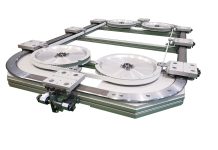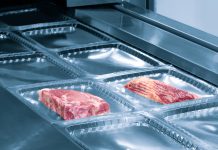
The palletizer is a device used to stack factory goods and products on to a pallet. It steps in at the end of the manufacturing line. These systems are designed to handle different kinds of products such as boxes, bundles, cans, cases, bags and more, so they can be adapted to customer needs. As end line packaging systems, become more and more automated, palletizing equipments need to be always more flexible and upgradeable for better running at peak performance and to better integrate in logistics. Industry also adopts robotic islands, a palletizer that gathers more than one robot able to pick up and stack pallets and different goods. These operations are made quickly and in strict connection with all the others production line devices. This means no more palletizers depending on the filling machine speed, with sharp production speed changes due to some packs dropping. The newest solutions are linked with the entire system. Speed modulation is a key element. It is constantly changed according to the needs, decreasing the machines wear and with a consequent energy saving.

Palletizing process steps
Palletizing process includes different steps: regulation of the packs flow into the palletizer; product turning; layer forming and consolidation; finished pallet collecting and storage. The speed modulation of the packs flow into the palletizer is intended to create the proper distance among the packs and to count them. The packs are moved by a conveyor systems before the palletizer, they are gathered, accumulated and one or more rollers controls their entry into the palletizer, pacing them for the count. Products handling can be one by one or in batch. The pack turning is to optimize the pallet stability and to set the right number of products on each layer. Once the packages or the batches are precisely oriented, they are set close one to the other, to form a layer. This operation can be in the same direction of the package flow or require a 90 degrees turning respect to it. When the layer is ready and before its picking and stacking on the pallet, it must be consolidated. This operation can vary according to the different kinds of pallettizers.

Technical characteristics
Palletizers can be automatic or semi automatic (devices where part of the work is done manually or under the operator control and the remaining is done automatically). They are used for cartons, crates, boxes, bags, cans, bundles, bottles, jars, vessels and, in general, for high and medium speed productions. Palettizzers have high precision mechanical elements to handle products one by one or in groups. Packs and already formed layers can enter according to the line direction or must be rotated of 90 degrees. In the first lay out, products entry and layer making are in the same direction; in the second one the packages flow perpendicularly to the pusher movement, transferring the formed layer on the pallet. Automatic pallettizers pick up the semifinished product from a stack and put it down on specific machines. They are equipped with systems with suction cups-boxes, or with clamps. Palletizers can be high level infeed or low level infeed devices; in multibrand version or robotic islands. Robots are inspired by the anatomy of the human arm and they can carry out complex and precise handling tasks. As the robot structure is a commercial product, the hand or better the gripping head is the main difference among the many different proposals. There are head with double rollers, magnetic grips, clamps, pneumatic tubes, mechanical, magnetical and pneumatical ones, other work with vacuum. There are single or multiple gripping heads, with vacuum or suction cups, multi-purposes to handle both packages and packaging materials and more. The newest robotic palletizers have a reduced footprint. They have different possible configurations: 4 or 6 axis robots. They can work on multiple lines at the same time to guarantee the required output and satisfy different lay-out demands. While the robotic arm structure doesn’t vary much with the item to handle, the end-of-arm tooling system is specific. According to speed and to the kind of product to handle, the firm can chose multi-lines pallettizers, working on more than one pallet at the same time or with more than one entrance for assorted products (carboard boxes, bundles etc). Many devices are able to stack two different products on two different pallets at the same time. They can work with top or bottom loading, they can have a sheet dispenser or automatically bind the layers. Their software optimize the changeover time and also the pattern management is simple; a user-friendly interface provides an easy designing and exchange of programs. The inbuilt database of the customized solutions can be recalled on screen or printed when necessary to simplify the operators work. With the controls and supervision package by P.C. Pallettizing is easy and flexible.
Glossary
Palletizing operation: place cartons, bags, boxes, bottles and other goods on pallets, that’s to say on a wooden platform to make it easy to move many products at the same time without excessive stress. By palletizing any kind of product is prepared for delivery, transport or warehousing according to national and international metric standards.
Robots: these are machines that quickly succeed in arranging a large number of boxes, bags, bottles or fragile and valuable staff on a pallet. Robots can be space savers (for instance the single arm ones) or they can have a large footprint when they have many components such as rollers, elevators or are connected to other industrial robots.
Depalletizing: as the pallet became a standard for most of the firms, the use of depalletizers to remove the items previously stocked for transport became essential for any industrial production line. Depalletizers are devices that download (depalletize) packages or products from the pallet in no time and without much effort or manual work.



